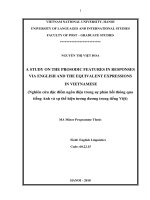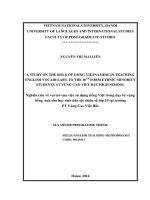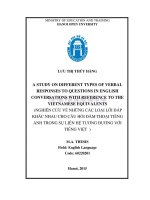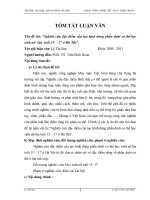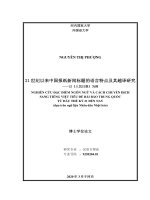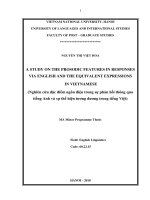a study on the prosodic features in responses via english and the equivalent expressions in vietnamese = nghiên cứu đặc điểm ngôn điệu trong sự phản hồi thông qua tiếng anh và sự thể hiện tương đương trong tiếng việ
Bạn đang xem bản rút gọn của tài liệu. Xem và tải ngay bản đầy đủ của tài liệu tại đây (623.55 KB, 48 trang )
1
VIETNAM NATIONAL UNIVERSITY, HANOI
UNIVERSITY OF LANGUAGES AND INTERNATIONAL STUDIES
FACULTY OF POST – GRADUATE STUDIES
*************************
NGUYỄN THỊ VIỆT HOA
A STUDY ON THE PROSODIC FEATURES IN RESPONSES
VIA ENGLISH AND THE EQUIVALENT EXPRESSIONS
IN VIETNAMESE
(Nghiên cứu đặc điểm ngôn điệu trong sự phản hồi thông qua
tiếng Anh và sự thể hiện tương đương trong tiếng Việt)
MA Minor Programme Thesis
Field: English Linguistics
Code: 60.22.15
HANOI - 2010
2
VIETNAM NATIONAL UNIVERSITY, HANOI
UNIVERSITY OF LANGUAGES AND INTERNATIONAL STUDIES
FACULTY OF POST – GRADUATE STUDIES
*************************
NGUYỄN THỊ VIỆT HOA
A STUDY ON THE PROSODIC FEATURES IN RESPONSES
VIA ENGLISH AND THE EQUIVALENT EXPRESSIONS
IN VIETNAMESE
(Nghiên cứu đặc điểm ngôn điệu trong sự phản hồi thông qua
tiếng Anh và sự thể hiện tương đương trong tiếng Việt)
MA Minor Programme Thesis
Field: English Linguistics
Code: 60.22.15
Supervisor: Nguyễn Thị Bích Ngọc, M.A
HANOI - 2010
6
TABLE OF CONTENTS
Page
DECLARATION i
ACKNOWLEDGEMENT ii
ABSTRACT iii
TABLE OF CONTENTS iv
LIST OF SYMBOLS vii
LIST OF TABLES viii
PART A: INTRODUCTION 1
1. Rationale 1
2. Aims of the study 1
3. Scope of the study 2
4. Method of the study 2
5. Structure of the study 2
PART B: DEVELOPMENT 4
CHAPTER 1: THEORETICAL BACKGROUND 4
1.1. Sentence and Utterance 4
1.1.1. Sentence 4
1.1.2. Utterance 5
1.1.3. Response as an utterance 6
1.2. Speech Acts 7
1.2.1. Classification of speech acts 7
1.2.2. Response as an act of speech 9
1.3. Prosodic Features 10
7
1.4. Intonation 10
1.4.1. Definition of intonation 10
1.4.2. Structure of intonation 11
1.4.2.1. The falling tune 13
1.4.2.2. The first rising tune 14
1.4.2.3. The second rising tune 14
1.4.2.4. The falling rising tune 15
1.4.3. Functions of intonation 15
1.4.3.1. The attitudinal function 16
1.4.3.2. The accentual function 16
1.4.3.3. Grammatical function 16
1.4.3.4. The discourse function 17
1.5. Summary 17
CHAPTER 2: METHODOLOGY 18
2.1. Context setting 18
2.2. Participants 18
2.3. Data collection 19
2.4. Research questions 19
2.5. Data analysis framework 20
2.6. Summary 20
CHAPTER 3: FINDINGS 21
3.1. Findings 21
3.1.1. Differences in responses between teachers and students 21
3.1.2. Agreeing samples via English and equivalent expressions in Vietnamese 22
3.1.2.1. Teacher towards students 23
3.1.2.2. Students towards teacher 24
3.1.3. Disagreeing samples via English and equivalent expressions in Vietnam 26
8
3.1.4. The functions of intonation in responses 27
3.1.4.1. Intonation of agreement 28
3.1.4.1.1. The attitudinal function 28
3.1.4.1.2. The accentual function 29
3.1.4.1.3. The discourse function 30
3.1.4.1.4. Grammatical function 31
3.1.4.2. Intonation of disagreement 32
3.1.4.2.1. The attitudinal function 32
3.1.4.2.2. The accentual function 33
3.1.4.2.3. The discourse function 33
3.1.4.2.4. Grammatical function 34
3.2. Summary 34
PART C: CONCLUSION 35
1. Recapitulation 35
2. Limitations and suggestions for further study 36
REFERENCES 37
APPENDIX 1. I
9
LIST OF SYMBOLS
1. Symbol of stress: '
2. Symbols of intonations
- The glide down:
- The glide up:
- The take - off:
- The Dive:
3. Tonic syllable: Underlined part in an utterance.
4. Utterance is pulled:
10
LIST OF TABLES
Table Page
Table 1. Agreeing samples of teachers towards students 23
Table 2. Agreeing samples of students towards teachers 25
Table 3. Disagreeing samples of teachers towards students 27
11
PART A: INTRODUCTION
In this part, the rationale which explains the reasons for choosing this topic, the
aims of the study which illustrates typical goals, the scope of the study which narrows
down the research scale and the structure of the study which builds up a frame are
established clearly.
1. Rationale
Prosody plays an important role in communication. Through prosody, people can
express their emotion state or sentiment tone. People can use prosody to show their
attitudes such as happiness, sadness, anger, love or hate. However, during communicative
process, it is easy to recognize that many speakers cope with problems in using prosody.
They sometimes do not know exactly how to use prosody in speaking and even in some
cases not understand the real meaning of utterances from speakers. Consequently,
understanding and choosing suitable prosodies will fill in the gaps in communication.
Moreover, choosing fitted prosodic features is necessary because this will help
speakers in reaching their aims in communication. For example, speakers may raise their
tone at the end of the utterance in asking instead of using question words as in: ''While the
teacher is teaching, students can talk''.
One more reason for choosing responses as the topic of the study is that response is
a factor in communication that helps speakers or hearers go on the conversation, depending
on the way they response to the others.
We hope that the study not only contributes a small part in the success of each
conversation but also can be considered as the ground stage for further researches.
2. Aims of the study
Due to the study is limited in the context of classroom in general and prosodic
features in responses between the teachers and students in particular as stated in scope of
the study, therefore, the goals of the study are as follows:
* To find out the similarities and differences in the responses between teacher and
students in context of a class.
* To look at the way how teachers and students express their responses showing
agreement and disagreement in classroom context.
12
* To find out the prominent intonation strategies preferably used in agreeing and
disagreeing responses by teacher and students.
3. Scope of the study
The study investigates responses in the level of speech acts. There are many kinds
of responses such as responses to a letter, responses to a question, responses to an
invitation and so on. Nevertheless, this study focuses on responses of teachers and students
in showing agreements and disagreements. In addition, the study examines chiefly
prosodic features in which intonation in utterances will be paid attention.
Moreover, due to the limitation of time, ability as well as knowledge, the research
context chosen is in English classes in grade 11 at Ischool Hatinh where the researcher
observes and describes mostly the actions and responses between teacher and students.
4. Method of the study
The study bases on quantitative research, which is to determine the relationship
between one thing and another. Quantitative research designs are either descriptive or
experimental, which means that we use personal observation and facts to form general
rules.
The participants of the study include teacher and students at Ischool Hatinh high
school.
5. Structure of the study
The study is divided into three main parts: Introduction, Development and
Conclusion.
Part A. Introduction:
As many other studies, this part introduces briefly the rationale, aims, the scope,
methods and organization of the study.
Part B. Development
This part includes three chapters:
* Chapter 1: Theoretical background
This is an overview of the related theories. It also concerns the previous works and
issues on speech acts and prosodic features. In each part, there are many sub-terms that
explain Speech Acts theory, sentence and utterance, similarities and differences in the
13
responses between teacher and students, response as an utterance, definition of intonation,
structures and functions of intonation.
* Chapter 2: Methodology.
This chapter introduces quantitative method as the main method for the research. In
particular, it describes the research questions, participants, data collection and data analysis
framework.
* Chapter 3: Findings
This chapter presents findings on intonation in agreeing and disagreeing responses
of teacher and students in class context.
Part C. Conclusion
The last part will summarize the over all of the study and provide limitation and
suggestions for further study.
14
PART B: DEVELOPMENT
CHAPTER 1: THEORETICAL BACKGROUND
All the related theories are covered in this chapter. Sentence, utterance and
response are the foundation for Speech acts and Prosodic Features.
1.1. Sentence and Utterance
1.1.1. Sentence
According to Crystal (1980: 319-320) ''sentence is an expression in natural
language, often defined to indicate a grammatical unit consisting of one or more words
that generally bear minimal syntactic relation to the words that precede or follow it''.
A sentence can include words grouped meaningfully to express a statement, question,
exclamation, request or command. As with all language expressions, sentences may
contain both function and content words, and contain properties distinct to natural
language, such as characteristic intonation and timing patterns. Sentences are generally
characterized in English by the presence of a finite verb for example in the following
sentence "She gives me a dollar", ''give'' is a finite verb. Crystal (1991: 321) classified
sentence into four main types basing on their structure:
* Simple sentence consists of a single independent clause with no dependent
clauses. The sentence below has one independent clause, which contains one subject: baby,
and one predicate: cried.
Eg: ''The baby cried''.
* Compound sentence consists of multiple independent clauses with no dependent
clauses. These clauses are joined together using conjunctions, punctuation, or both.
Eg: ''Do you want to stay here or go shopping with me?''.
* Complex sentence consists of at least one independent clause and one dependent
clause. As we can see in the following example:
Eg: ''I ate the meal that you cooked''.
. ''I ate the meal'' is an independent clause and ''that you cooked'' is a relative clause.
* Complex-compound sentence (or compound-complex sentence) consists of
multiple independent clauses, at least one of which has at least one dependent clause.
15
Eg: ''The dog lived in the backyard, but the cat, who knew he was superior,
lived inside the house''.
Basing on their purpose, sentence are divided into five types, exclamative,
imperative, informative, declarative and interrogative sentences (Crystal. 1991: 322)
* Exclamative sentence: An exclamative or exclamatory sentence expresses the
speaker's emotion.
Eg: ''I'll never finish this paper in time!''
* Imperative sentence: An imperative sentence gives anything from a command or
order, to a request, direction, or instruction. Imperative sentences require audiences, as
their aim is to get the person spoken to either do or not do something.
Eg: ''Look at me''.
* Informative sentence is more for the mutual benefit of both the listener and the
speaker, and, in fact, requires more of an interaction between both parties involved.
Eg: ''We are going to school now''
* Declarative sentence is the most common kind of sentence in language, it states
an idea (either objectively or subjectively on the part of the speaker) for the sheer purpose
of transferring information to the receiver. In writing, a statement will end with a period.
Eg: ''The earth goes around the sun''.
* Interrogative sentence asks a question and, therefore, ends with a question mark.
Eg: "What do you want?"
In general, ''sentence is neither a physical event nor a physical object. It is,
conceived abstractly, a string of words put together by the grammatical rule of language''.
(Hurford & Heasley. 2003: 17).
1.1.2. Utterance
Hurford & Heasley (2003: 15) stated, ''An utterance is used by a particular speaker,
on a particular occasion, of a piece of language such as a sequence of sentences, or a
single phrase or even a single word". Utterance is certainly used in speaking not in writing
because an utterance is a natural unit of speech, a complete unit of talk. Hurford & Heasley
(2003: 15), moreover, explained the way to express sentence and utterance: "We adopt the
convention that anything written between double quotation marks represents an utterance
16
and anything italicized represents a sentence or part of sentence such as a phrase or a
word.''
Eg: ''Help" represents an utterance
''The postillions have been struck by lightening'' represents a sentence
(Hurford & Heasley. 2003: 16).
Following the ideas of Hurford and Heasley, from the beginning to the end of the
study, all utterances and sentence will be illustrated in the form above.
1.1.3. Response as an utterance
In Longman Dictionary of Applied Linguistics (1985: 273), Richards et al. defined
response as ''an act of answering or replying''. Response can be verbalized by physical
response or an utterance. For example, students may answer their teacher's question as
follows:
Teacher: (angry) '' How many of you complete the homework?''
Mai: ''I am sorry''
Lan: (looks down and doesn't say anything)
Lan and Mai answer their teacher's question in different ways and the teacher
understands that his/her students haven't finished their homework yet.
The content of the response is based on the meaning of the previous question as in
the example above. In some other cases, the question is an implication so that the hearer
must answer fitly to it. For example, during a lesson, while the teacher is teaching, Tu, a
school boy, is not paying attention to the lecture, and the teacher says to him:
Eg: Teacher: ''What is the meaning of not paying attention Tu?''
Tu: ''I am sorry"
In this case, Tu understands the implication of his teacher's question, which means
reminding him to concentrate on the lesson so that Tu apologies for not paying attention.
However, if Tu did not understand the real meaning of the question, he would explain the
meaning of "not paying attention".
In one another case, if the sentence is too long, the speaker may use intonation to
emphasize the key words for example:
17
Eg: "this 'afternoon, I will have a dis'cussion with our 'headmaster about
studying English through extra curricular activities so that the
'deadline for the 'essay will be to'morrow''.
In answering, addressees may use body language to answer instead. However, with
the limitation of the study, the research only pays attention to the verbal language in
utterances which were collected from observation and interviews.
1.2. Speech Acts
1.2.1. Classification of speech acts
Austin (1962: 75) determined that ''Many utterances do not communicate
information but are equivalence to actions. In many cases to say something is to do
something''. The actions such as agreeing, disagreeing, shocking, promising, ordering,
greeting, warning, inviting or congratulating and so on are acts of speech. The example
below can be interpreted in different meanings:
Eg: ''Our headmaster is over there".
(a). It could be uttered as a means of complaining to a students that they are very
noisy then.
(b). It could be understood as a warning of teacher to his students not to make any
trouble because their headmaster is looking at them.
(c). It could be uttered to introduce the headmaster to students.
Each of utterance can include its meaning, which is why Austin (1962), Searle
(1976) and Quang (2009) said that ''to make an utterance, the speaker must do three acts:
Locutionary, Illocutionary act and perlocutionay act''. In addition, in Austin's theory
(1962: 75), speech acts included three levels: The first is locutionary act, which is the
performance of an utterance, the actual utterance and its ostensible meaning in the sense of
"say" based on words or structure of the utterance.
Eg: "I want to drink an orange juice"
The speaker wants to produce a locutionary act with the example above. Moreover,
people rarely make an utterance without having any purpose. In the utterance above, the
speaker not only wants to drink orange juice but also intends to make a requirement. This
kind of action is called illocutionary. In addition, Austin classified the third level
perlocutionary act which performs intended or unintended affect to the hearer or speaker.
Yule (1996: 48) also agreed by saying, "In communicating, we do not simply create an
18
utterance without intending to have an effect". So in the utterance "I want to drink an
orange juice, the speaker certainly wishes the act of bringing a glass of orange juice to be
done. That action is called perlocutionary act.
Beside the theory of Austin, Searle (1976: 54) divided speech acts into five types:
(1) Commissives are acts that commit the speaker in doing something in the future
such as promising, swearing, threatening etc.
Eg: ''I will come back tomorrow, I promise''.
(2) Declaratives are acts that can change the available situation via utterance.
Eg: ''I now pronounce you husband and wife''.
(3) Directives are acts that get the hearers to do something because they are acts of
offering, requesting or ordering.
Eg: "Could you open the door?"
(4) Expressives are the ways that speakers express their feelings and attitudes such
as apologizing, thanking, congratulation etc.
Eg: "Congratulation! You've passed your examination".
(5) Representatives/ assertives are acts that the speakers utter the assertions, reports
or conclusions and they are responsible for that situation.
Eg: ''I am sure that he is wrong''
Yule (1996: 49) classified acts into direct and indirect acts. He stated direct acts as
''the direct relationship between a structure and a function'' meanwhile ''indirect
relationship between a structure and a function is indirect act'' (Yule, 1996: 49). For
example:
Eg 1. Student: "I think the topic ''friendship'' is related to culture shock''.
Teacher: ''Really? I do not agree with you''. (a)
Eg 2. Student: "In my opinion, we should come back to the bus stop to find
the boy".
Teacher: "Actually, we can find another way''. (b)
Eg 3. Student: I think the girl should apologise the boy
Teacher: ''Good! How about others' opinions?'' (c)
19
(a) is a direct act because it shows the direct disagreement to the hearer's opinion
and the hearer can understand immediately. Meanwhile, the utterances (b) and (c) are
indirect disagreement of the teachers to their students. The teacher wants to refuse in the
most polite way and even elicit the other answer. Searle (1976: 54) also added, ''In indirect
speech acts the speaker means more than what it is said''. Therefore, the act as (b) and (c)
can be seen as indirect answers.
In the range of speech acts theory proposed by Searle (1976), acts are very helpful
in different contexts, agreeing and disagreeing responses between teachers and students are
put in representative acts. In Yule's theory (1996), these acts can be direct and indirect acts.
1.2.2. Response as an act of speech.
As mentioned above, response in conversation is an utterance. Furthermore, the
idea of the linguistics such as Austin (1962) and Quang (2009) that ''to make an utterance,
the speaker must do three acts: Locutionary, Illocutionary and perlocutionay act was
highly appreciated.
Besides, there are different ways to respond, there are many kinds of responses, and
there are many factors affecting the responses. Moreover, the responses in different
contexts can be not entirely agreement or disagreement. However, we limit the paper in the
first part is in case study. Therefore, agreement and disagreement responses between
teachers and students in this study will be taken into consideration under theory of Yule
about direct and indirect acts.
1.3. Prosodic Features
Prosody has been studied as a knowledge source for speech understanding and has
been successfully used in many researches. In the recent years, the number of studies
related to speech acts has increased. Speech acts are more natural and spontaneous. The
prosody usages, therefore, are much more important and necessary. However, this is not a
simple scale because when an utterance is analyzed, the speaker's implication will be better
known through the way he/she stresses, the way he/she uses intonation and rhythm.
In Longman Dictionary of Language Teaching and Applied Linguistics, Richard et
al. (1992: 355) stated that ''Stress is the pronunciation of a word or syllable with more than
the surrounding words or syllables. A stress word or syllable is produced by using more
air from the lung''.
20
Rhythm, on the other hand, is ''creating by the contracting and relaxing chest,
muscles'' (Richard, J. C et al. 1992: 346).
Intonation is defined as ''raises and falls in pitch level'' (Richard, J. C et al. 1992:
155) and will be clarified in the next part.
Stress, rhythm and intonation are important factors in prosodic features in which
each factors have private functions. However, within the limitation of the study, the thesis
will mostly focus on intonation in the following part.
1.4. Intonation
1.4.1. Definition of intonation
Intonation is a famous component in making every utterance. This is also an
interesting topic for researchers. There are different definitions about intonation.
According to Quang and Tam (2009: 37) English intonation was ''the rises and falls
in pitch level''. This means that when we utter any sentences, intonation is presented.
O'Connor (1973: 78) pointed out '' when we talk about English intonation we mean the
pitch patterns of spoken English, the speech tunes of melodies, the musical features of
English''. Intonation is a feature of spoken language.
Richard, J. C et al. (1992: 190) explained, "When speaking, people generally raise
and lower pitch of their voice, forming pitch patterns. They also give some syllables in
their utterances a greater degree of loudness change their speech rhythm. These
phenomena are called intonation. Intonation does not happen at random but has definite
patterns, which can be analyzed according to their structure and functions. Intonation is
used to carry information over and above which is expresses by the words in the sentence''.
Intonation is related to sentence, stress is related to word but tone is related to syllable.
Tone is the use of pitch in language to distinguish words. According to Roach (1983: 62),
''a unit of speech bounded by pauses has movement, of music and rhythm, associated with
the pitch of voice''. This certain pattern of voice movement is called tone. Through tones,
speakers' signals, i.e. proclamations, agreements, disagreements, questions or hesitations
are shown. Ladefoged (1982: 52) identified four basic tones (fall, rise-fall, rise, and fall-
rise) while Roach (1988: 127) gave out five tones: fall, rise, rise-fall, fall-rise, and level).
Level is rarely used so that in communication, tone should be based on fall, first-rise,
second-rise and fall-rise.
1.4.2. Structures of intonation
21
The intonation in English is different from stress, which is related to stress of a
syllable in a word. Most of English words have their own stress placement. Intonation on
the other hand, concerns on utterance in conversation. In English, according to Roach
(1988: 121), structure of an individual tone unit consists: Head, Pre-tonic segment, Tonic
or nucleus and Tail.
Tonic unit
Head
Pre-head
Tonic/nucleus
Tail
A head is all that part of a tone-unit that spreads from the first stressed syllable to
the tonic syllable (not including tonic syllable). Let us have a look at the following
example, which was quoted in Roach's book in 1988.
Eg: 'give me those (Roach, 1988:123)
The first two syllables are the head of the tone-unit (those).
Eg: 'Bill 'called to 'give me those (Roach, 1988:123)
The head is first five syllables
Eg: in an hour (Roach, 1988:123)
In this case, there is no stressed syllable before the head preceding the tonic
syllable (hour), so that there is no head. "In an" in the example above is called pre-head.
Pre-head includes all the unstressed syllables before the head in a tone-unit.
Therefore, we can find out pre-head in two cases: The first is in the last example above.
The second is "in a" in the following example:
Eg: In a 'little 'less than an hour (Roach, 1988:124)
The pre-head is "in a", the head is "little" and "less than an" and the tonic
syllable is "hour".
Tail is between of tonic syllable and the end of tonic unit (''did you say" in the
example below). Tonic syllable is the most important and obligatory part of tonic unit.
Eg: What did you say? (Roach, 1988:124)
O' Connor (1973) argued that there are four basic shapes of tunes, which express
the speakers' feeling and intention. He furthermore, found out shapes of tune when having
22
a look at the dependence of important words, which are given stresses, in an utterance and
the attitude of the speaker. An utterance spoken words with different kinds of focus on
important syllables have different ways to be interpreted. As a result, there may be many
different tunes in utterances.
In short, catching intonation in conversation is necessary because it helps the
addressee to avoid misunderstanding in mutual relationship.
O' Connor (1973) proposed four shapes as follow:
1.4.2.1. The falling tune
The falling tune (the Glide-down) shows the definite assurance of the speaker.
It is mostly used in WH questions, exclamations, tag questions, yes-no questions,
responding to something previously informed or commands. The falling tune consists of a
fall in the voice from a high pitch to a very low one. The fall is on the stressed syllable or
from the stressed syllable to a following one:
Eg: Teacher: ''Definitely''
/'definitli/
It is necessary to know that on a single syllable the voice falls within the
syllable. Either on more than one syllable, the voice falls within the stressed syllable or it
jumps down from that syllable to the next. Alternatively, unstressed syllables at the end are
all very low.
If there are any unstressed syllables before stressed syllables, this can be shown
that:
Eg: Student: "I agree"
/ai ə'gri:/
In groups with more than three important words, the stressed syllable of each one
is lower than the one before; this is why tune the glide-down is named. Another way of
showing the Glide-Down, which is simpler and quicker than the dots and lines used up to
now. Before the stressed syllable where the voice falls we put ('). So: 'Definitely. Notice
that no other mark is needed to show the very low unstressed syllables at the end - any
unstressed syllables after a fall are always low.
23
Therefore, with these few marks we can show all the features of the glide-down.
They are mostly used in definite statement or an assurance.
1.4.2.2. The first rising tune
The first rising tune is called the Glide- up. It just likes the glide down except that it
ends with a rise in the voice instead of a fall. Both important and unimportant words before
the rise are treated exactly as in the Glide-Down.
Eg: Teacher: ''Is it right or wrong?''
/iz it 'rait ɔ: 'rɔη/
The unstressed syllable at the beginning of the utterance above is low. Then the
voice jumps up to stressed syllable with high tune. Therefore, it is called the first rising
tune. Note that, in this kind of utterance, the stressed syllable may be at the beginning of
the utterance as follow:
Eg: Teacher: "Right or wrong?"
/'rait ɔ: 'rɔη/
1.4.2.3. The second rising tune
The second rising is called Take-off. After the glide-down and the glide-up, we
have the take-off. This also ends with a rise in the voice, like the Glide-Up, but any words
and syllables before the rise are low. The Take-off tune, moreover, is often used in
utterance with anger and annoyance of the speaker.
Eg: Student: ''Yeah, I see your opinion"
/ jeə ai si: jɔ: ə'piniən/
We call it the Take-Off because, like an aeroplane taking off, it starts by running
along at a low level and finally rises into the air. The rise, as in the Glide-Up, either takes
place on one syllable, like everything, or it is spread over several syllables.
1.3.2.4. The falling rising tune
The falling rising tune is called the Dive. The falling-rising tune is mostly used in
hesitated or uncertain utterance. In this part, the voice falls from high note to low then rises
to about the middle of voice.
24
Eg: Teacher: ''That is right''
/'ðæt iz 'rait/
1.4.3. Functions of Intonation
Intonation is especially important for who is speaking, for who will speak in the
next turn, for how the act will be understood as an apology, thank or explanation etc. In
conversations in general and in a specific case as in a class, the use of intonation is much
more paid attention.
According to Arne Vanvik (1979: 64), there are three fundamental functions of
intonation: grammatical, delimiting and expressive. When pitch variations constitute the
only difference between a question and an assertion, intonation has a grammatical function.
This is so-called grammatical function. When intonation signals continuation or
termination that is delimiting function For example, in some regions, the desire for
continuation is usually associated with a rising pitch at the end of an utterance, while a
falling pitch usually represents an intention to conclude. A question normally demands an
answer. The third one, the expressive function of intonation, gives us an indication of the
speaker's mood, feelings or attitude towards his/her subject or audience.
Nguyen Huy Ky (2006: 36) mentions that there are six functions: Grammatical
function, attitudinal function, accentual function, discourse function, pragmatic function
and distinctive function.
In this study, we follows the view points of Roach (1988), Quang & Tam (2009)
that there are four main functions of intonation:
1.4.3.1. Attitudinal function:
Intonation is used to express feelings, attitudes of the speaker in different situations.
In the example below, we can see that the speaker may utter in different tones to make the
hear understand his/her real meaning.
Eg: Student: "I agree"
Student may utter with happy voice to show their eagerness with fall-rising
tune as: /ai ∂'gri:/
25
Student may say with sad voice to show their indisposing in doing
something by using falling tune: /ai ∂'gri:/
1.4.3.2. Accentual function
Intonation helps to mark certain syllables or words as prominent and therefore
important in term of information. This function is related to tone-unit. The most common
position for this is in the last lexical word of a tone-unit. Roach (1988: 143) also points that
"for contrastive purpose any word may become the tonic syllable". In the following pairs
of examples, (a) represents a normal agreement and (b) is a contrastive:
(a) '' That is a good idea"
/ ðæt iz ə gud ai'diə /
(b) " That 'isn't a good idea"
/ ðæt 'iznt ə gud ai'diə /
1.4.3.3. Grammatical function
Intonation provides information based on grammatical structure. By using a
particular pattern of intonation, the speaker can imply a statement, a question, an ordering,
or an exclamation as the following example:
Eg 1: She is coming
/∫i: iz 'kʌmiη/
With the falling tune, it shows a statement
Eg 2: She is coming
/∫i: iz 'kʌmiη/
With the rising tone, it implies a question
1.4.3.4. Discourse function:
In this function, intonation makes the speaker and the hearer to achieve what is
called new information (unknown information) and old information (already known
26
information). Normally, "the falling tones indicated new information while rising tones
indicated given information".
Eg: Teacher: "your first answer about extend family is good"
/ jɔ: fə:st 'ɑ:nsə ə'baut iks'tend 'fæmili iz 'gud /
1.5. Summary
Since the main idea of this chapter is establishing viewpoints of related theories, all
necessary parts are presented clearly.
Firstly, it is obvious to recognize difference between sentence and utterance.
Sentence with full of grammatical structures used in written language meanwhile utterance
is used in spoken language.
The second part is about speech acts, which are very important to identify acts of
agreements and disagreements in class context. In this part, the theory of Yule (1996)
about direct and indirect acts is taken into account.
In addition, an introduction about prosodic features in general and intonation in
particular is put into the direction of the study. Therefore, the researcher pays attention to
the structures and functions of intonation in the light of legendary linguists.
CHAPTER 2: METHODOLOGY
27
In this chapter, the context of the study, Participants, Research Questions, Data
collection and Data analysis will be taken into consideration.
2.1. Context setting
Besides using quantitative analyses as the methods for studying, we are sure that
the topic is too large to study. Hence, we would like to put it in typical case to study.
The context here is in Ischool Hatinh High School with the website is ischool.vn.
This is a private high school with fourteen classes in three grades 10, 11 and 12 under the
control of Nguyen Hoang group, a famous group in education and information technology.
Here "I" means "Innovative", "Intelligent" and "International".
There are three classes in grade 11 of which students are taken acquainted with
studying condition in this school. Therefore, class 11A will be chosen to study. All
students are in medium level of English.
Moreover, this is a high school where the researcher is working. Lifestyle,
psychology and ability of students are understood clearly. Although, the level of students is
in medium, the technology for teaching and studying are well invested such as stereo,
computer and other teaching facilities.
As the students' ability is limited, the Headmaster decided to teach four periods of
English per week instead three classes as in other high schools in the city. Besides teaching
lessons in textbook, five English teachers have to hold the reflex classes, workshops,
English-speaking club to improve the students' language skills. Therefore, in this study, the
researcher joins reflex classes to take note and to record conversations between teacher and
students. The conversations were joined in May 2010.
2.2. Participants
One American teacher whose name is Rory Bradley, is 35 years old and has taught
for many years as volunteer teacher in Vietnam and now he is invited to join the study.
Bradley is an enthusiasm teacher, who gives out many new methods in studying English.
His pronunciation, moreover, is excellent. Therefore, it is believed that all his utterances in
communication in class context are perfect.
In the study program, Bradley teaches in reflex class. He is in charge of discussions
three topic about "family", "friendship" and "love" The time for each period is forty-five
minutes. With these topic discussions, Bradley teaches in three periods, which are on
Monday, Wednesday, and Saturday afternoon.
28
The students involved are forty-two students in class 11A. Their English skills are
medium but they all are very eager to study English in extra activities.
We are aware that if we have more participants and condition, we will have more
samples to study. However, the topic is only in some specific cases. We believe in teaching
experiment of teacher and the truthful answers of students. Therefore, the number of
participants and the talking times between them will be carefully studied.
2.3. Research questions
The research questions will be answered in the next chapter as the body of thesis.
Moreover, the questions have not been answered yet by any of previous papers.
1, What are the similarities and differences in the responses between teacher and
students at Ischool Hatinh High School?
2, How do the teachers and students express their agreement and disagreement in
conversations?
3, What are the prominent intonation strategies preferably used via agreeing and
disagreeing by teacher and students?
2.4. Data collection
Since the thesis is only in some cases in class, the data collection is entirely
authentic from the natural setting. The naturalistic observations and elicitation technique
will be used in this thesis.
The observation of communications between the teacher and students in a class
11A was mostly in form of note-taking, interviewing and recording. The lessons, which
has just introduced above, are speaking lessons about factual topics such as "family",
"friendship" and "love". All those lessons are taught at room number A21 at Ischool Hatinh
high school.
The conversations, which are collected carefully and taken note or sometimes
recorded to clarify the intonation of users, are expressed in appendix.
In addition, the researcher also interviews Bradley to reconfirm the intonation he
used in the lessons.
2.5. Data analysis framework

